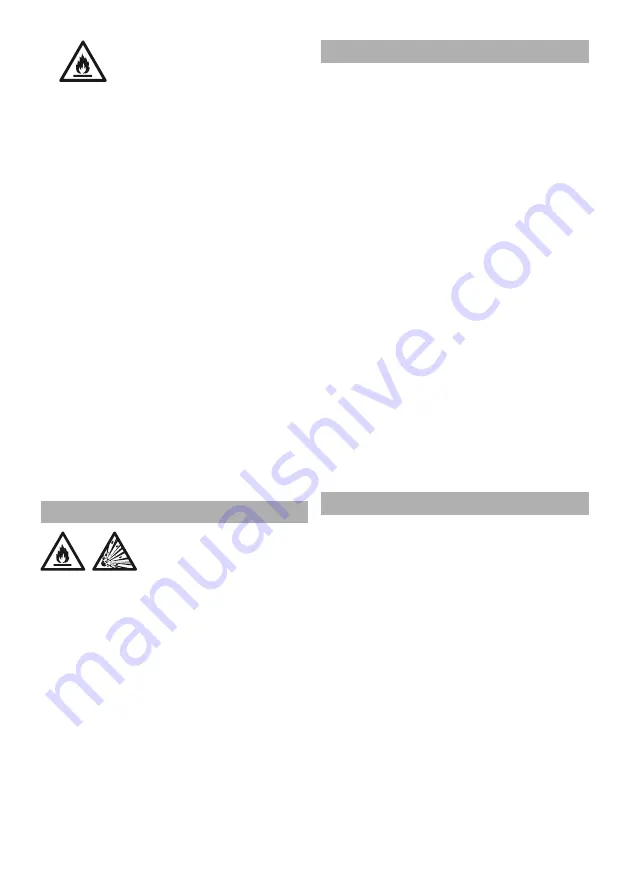
Page 3
For technical questions, please call 1-888-866-5797.
Item 57249
9.
The battery Charger gets hot during
use. The Charger’s heat can build
up to unsafe levels and create a
fire hazard if it does not receive adequate
ventilation, due to an electrical fault, or if it is
used in a hot environment.
Do not place the Charger on a flammable
surface. Do not obstruct any vents on the
Charger.
Especially avoid placing the
Charger on carpets and rugs; they are not
only flammable, but they also obstruct vents
under the Charger.
Place the Charger on a stable, solid,
nonflammable surface (such as a stable metal
workbench or concrete floor) at least 1 foot away
from all flammable objects, such as drapes or
walls. Keep a fire extinguisher and a smoke
detector in the area. Frequently monitor the
Charger and Battery Pack while charging.
10. People with pacemakers should
consult their physician(s) before use.
Electromagnetic fields in close proximity to
heart pacemaker could cause pacemaker
interference or pacemaker failure.
11. The warnings, precautions, and instructions
discussed in this instruction manual cannot
cover all possible conditions and situations that
may occur.
It must be understood by the operator that
common sense and caution are factors
which cannot be built into this product,
but must be supplied by the operator.
Lithium Battery Safety Warnings
LITHIUM BATTERIES
STORE A LARGE AMOUNT
OF ENERGY AND WILL
VENT FIRE OR EXPLODE IF MISTREATED:
1. Keep Battery Pack dry.
2. DO NOT DO ANY OF THE FOLLOWING
TO THE BATTERY PACK:
•
Open
•
Drop
•
Short-circuit
•
Puncture
•
Incinerate
•
Expose to temperatures greater than 265° F.
3. Charge Battery Pack only
according to instructions.
4. Inspect Battery Pack before every use;
do not use or charge if damaged.
Battery Charger Safety
1. SAVE THESE INSTRUCTIONS - This
manual contains important safety and
operating instructions for battery charger
Model 57249. Refer to charger manual
for additional safety instructions.
2. Before using battery charger, read all
instructions and cautionary markings on battery
charger, battery, and product using battery.
3. CAUTION - To reduce risk of injury, charge
only li-ion type rechargeable batteries.
Other types of batteries may burst
causing personal injury and damage.
4. Do not charge or use appliance
in rain, or in wet locations.
5. Do not use battery-operated appliance in rain.
6. Remove or disconnect battery after use,
before servicing, cleaning or removing
material from the gardening appliance.
7. Do not dispose of battery in a fire. The
cell may explode. Check with local codes
for possible disposal instructions.
8. Do not open or mutilate the battery. Released
electrolyte is corrosive and may cause damage
to the eyes or skin. It may be toxic if swallowed.
9. Exercise care in handling batteries in order not
to short the battery with conducting materials
such as rings, bracelets, and keys. The battery
or conductor may overheat and cause burns.
Vibration Safety
This tool vibrates during use.
Repeated or long-term exposure to vibration may
cause temporary or permanent physical injury,
particularly to the hands, arms and shoulders.
To reduce the risk of vibration-related injury:
1. Anyone using vibrating tools regularly or for
an extended period should first be examined
by a doctor and then have regular medical
check-ups to ensure medical problems are not
being caused or worsened from use. Pregnant
women or people who have impaired blood
circulation to the hand, past hand injuries,
nervous system disorders, diabetes, or
Raynaud’s Disease should not use this tool.
If you feel any symptoms related to
vibration (such as tingling, numbness,
and white or blue fingers), seek medical
advice as soon as possible.
2. Do not smoke during use. Nicotine reduces
the blood supply to the hands and fingers,
increasing the risk of vibration-related injury.


























